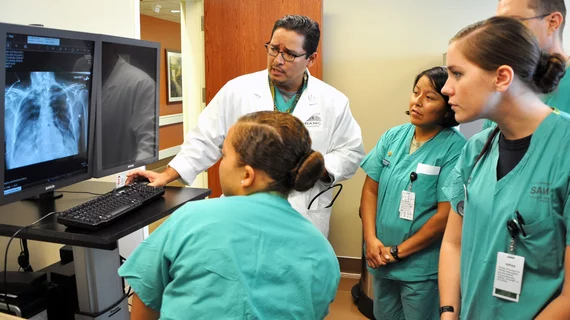The new generation of medical students is motivated by career fulfillment more than money
Radiology residents and medical students alike are driven more by fulfilling careers, work-life balance and interest in their specialty than financial aspirations or the job market itself, according to a Journal of the American College of Radiology-published study, suggesting trainees select a medical path based more on social and intrinsic motivations and less on external successes.
While fluctuations in the competitiveness of the job market tend to correspond with the demand and competition between radiology applicants, medical student interest has been unpredictable in the past half-decade, Adam J. Yen and colleagues wrote in JACR.
“The motivating factors that contribute to selecting a medical speciality have been assessed in previous studies and include many influences and preferences that are specific to the practice of medicine—medical school curricula, mentors, interest group participation, desire for patient contact, desire for intellectual challenge, acuity of the work, the patient population and so on,” the authors said. “However, broader categories of professional motivation, which have been well described outside the medical literature, have not typically been the main focus of surveys assessing selection of medical specialities.”
For their work, Yen et al. distributed an anonymous survey to first- through fourth-year medical students and radiology residents at the University of California, San Francisco, asking them to select their top three of seven possible motivating factors for choosing their medical specialty.
Factors ranged from prosocial motivations, like finding fulfillment in helping patients and contributing to society, to external motivations like social successes and financial security. The authors also focused on intrinsic motivations like inherent interest and enjoyment in an activity, and “loafing,” or the idea that a person is most drawn to the easiest path to their goals.
“Motivating factors that guide specialty selection among students likely evolve over the course of medical school,” Yen and co-authors wrote. “Certainly, students’ goals change over time as they are exposed to new fields and a broader range of practice environments, but general categories of psychological motivation may change as well.”
Analyzing responses from 243 medical students and 45 onsite radiology residents, the team found that three motivators stood out regardless of the individual’s stage of medical training or their selection of a “controllable” versus an “uncontrollable” lifestyle—finding daily work fulfilling, work-life balance and interest in their subject. The findings were consistent across all demographics, the authors said, and transcended age and level of debt.
“These findings were somewhat unexpected,” Yen et al. said. “Although previous surveys have failed to demonstrate that job market concerns significantly affect trainees’ career selection, we anticipated that the extra confidentiality measures in our survey administration might guard against any perceived judgment and reveal some motivation by extrinsic rewards.”
The researchers said they were surprised when no extrinsic factors emerged as important to the students, but noted a hiked interested in work-life balance from day one of medical school. Today’s medical students desire “lifestyle-friendly careers,” they wrote, which “may be indicative of a broader cultural shift in both medicine and society at large.”
Yen and colleagues said the new information can be easily applied to radiology in particular, where career advisors who have had trouble recruiting prospective radiologists in a pinched market can use this data to guide their conversations.
“For radiologists hoping to recruit students into our field, emphasizing what we find fulfilling and interesting about our work will likely be more effective than promoting the lifestyle benefits of the job, which, although desired, do not necessarily impact career selection as directly,” they wrote.

